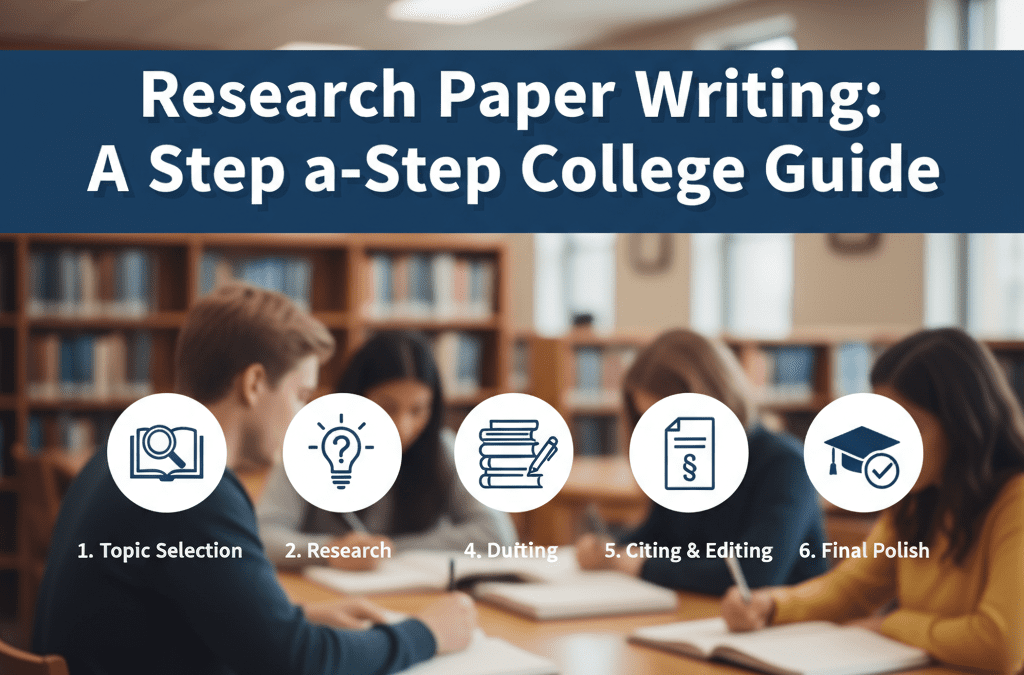Research Paper Writing: Step-by-Step College Guide to a Perfect Paper
Writing a research paper can feel intimidating — endless sources, complex topics, formatting nightmares, and strict deadlines. But here’s the truth: once you understand the process, research paper writing becomes a predictable and even enjoyable journey.
In this detailed guide, we’ll walk through the exact steps successful students use to plan, research, and write papers that impress professors in both the U.S. and U.K.
1️⃣ Understand the Purpose of Research Paper Writing
Before typing your first word, know why you’re writing. A research paper is more than just summarizing facts — it’s about forming and defending an argument with credible evidence.
As the University of Manchester Library puts it:
“A research paper shows how well you understand your topic, how deeply you’ve investigated it, and how effectively you communicate your findings.”
Good research papers show analysis, critical thinking, and clarity — not just information.
2️⃣ Choose a Strong and Focused Topic
Your topic is the foundation of your research paper. Pick something:
-
Narrow enough to manage within your word limit
-
Relevant to your course or discipline
-
Backed by sufficient sources
Avoid topics that are too broad, like “Global Warming.” Instead, refine it to something focused like “The Impact of Renewable Energy Adoption on University Carbon Footprints in the UK.”
💡 Pro Tip: Use tools like Google Scholar or JSTOR to gauge how much research is available.
3️⃣ Conduct Thorough Research
This stage is where most of your time goes — and where your essay gains depth.
-
Gather academic sources: peer-reviewed journals, books, and credible websites.
-
Take organized notes — group them under main arguments.
-
Always record your sources for easy referencing later.
Use reference management tools like Zotero or Mendeley to keep your citations tidy.
For more citation guidance, visit the Purdue Online Writing Lab.
4️⃣ Create an Outline for Your Research Paper
A solid outline keeps your paper logical and focused. Your structure might look like this:
-
Introduction – Define your topic, purpose, and thesis statement.
-
Literature Review – Discuss previous studies related to your topic.
-
Methodology – Explain how you collected data or analyzed sources.
-
Results/Findings – Present what you discovered.
-
Discussion – Interpret your results and compare them to previous research.
-
Conclusion – Summarize and suggest next steps or implications.
Your outline is your roadmap — it prevents writer’s block and keeps you on track.
5️⃣ Write an Engaging Introduction
The introduction sets the tone for your Research paper writing. It should:
-
Introduce the topic clearly
-
Provide background information
-
End with a strong thesis statement — your central argument
Example:
“This research paper investigates how hybrid learning models have improved academic performance among undergraduate students in the UK.”
Keep your introduction concise (10–15% of total word count) and directly connected to your thesis.
6️⃣ Build Your Body Paragraphs with Evidence
This is where your analysis takes shape. Each paragraph should:
-
Begin with a topic sentence
-
Present evidence (quotes, data, or citations)
-
Analyze and connect it to your main argument
Avoid dumping facts without commentary. Explain why each point matters.
Use subheadings (like H3s) to divide major sections — this improves readability and SEO.
Example H3:
Research Paper Writing Tips for Effective Analysis
7️⃣ Write a Powerful Conclusion
Your conclusion should never introduce new information. Instead, restate your thesis in light of your findings and highlight key insights.
Strong conclusions answer questions like:
-
What did I learn from my research?
-
Why does it matter?
-
What are the implications?
End with a forward-looking statement or a call to further research.
8️⃣ Proofread, Edit, and Format
Editing is as important as writing. Check for:
-
Grammar and punctuation errors
-
Logical flow between sections
-
Proper citations (APA, MLA, or Harvard)
If editing isn’t your strong suit, professional help can make a big difference.
At KeffEssays.com, we offer detailed feedback on research paper writing — helping students improve organization, clarity, and academic tone before submission.
9️⃣ Use Plagiarism Checkers and Academic Integrity Tools
Before submission, always check originality. Tools like Turnitin, Grammarly Premium, or Quetext can ensure your content is 100% plagiarism-free.
Remember: your professors use these tools too. Submitting unverified work can risk your credibility and grades.
🔟 Learn from Every Paper You Write
Each research paper writing is an opportunity to improve your academic voice and analytical skills. Save feedback from professors and apply it next time.
For more help structuring or editing future papers, visit Keff Essays Writing Help — where expert editors can guide you through each stage of the writing process.
